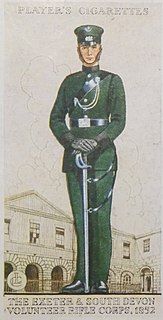Options for Change was a restructuring of the British Armed Forces in summer 1990 after the end of the Cold War.

The Royal Gloucestershire, Berkshire and Wiltshire Regiment was a short-lived infantry regiment of the British Army.

The Light Infantry was an infantry regiment of the British Army, part of the Light Division. The regiment was one of four 'large' regiments formed after the 1966 Defence White Paper through the amalgamation of units of the Light Infantry Brigade. Originally consisting of four battalions, it was later reduced to three battalions, and finally amalgamated into The Rifles with just two battalions which became the 5th and 3rd Battalions respectively.
The East and West Riding Regiment was a regiment of the British Territorial Army from 1999 to 2006. In 2006, it was re-designated as the 4th Battalion, Yorkshire Regiment.

The Devonshire and Dorset Regiment, usually just known as the Devon and Dorsets, was an infantry regiment of the British Army formed in 1958 by the amalgamation of two county regiments, the Devonshire Regiment and the Dorset Regiment. In 2007 it was itself merged into The Rifles, a "large regiment".

The Dorset Regiment was a line infantry regiment of the British Army in existence from 1881 to 1958, being the county regiment of Dorset. Until 1951, it was formally called the Dorsetshire Regiment, although usually known as "The Dorsets". In 1958, after service in the Second Boer War along with World War I and World War II, the Dorset Regiment was amalgamated with the Devonshire Regiment to form the Devonshire and Dorset Regiment. In 2007, it was amalgamated with the Royal Gloucestershire, Berkshire and Wiltshire Regiment, The Light Infantry and the Royal Green Jackets to form a new large regiment, The Rifles.
The Rifles is an infantry regiment of the British Army. Formed in 2007, it consists of five Regular battalions and three Reserve battalions, plus a number of companies in other Army Reserve battalions. Each battalion of The Rifles was formerly an individual battalion of one of the two large regiments of the Light Division. Since formation the regiment has been involved in combat operations, first in the later stages of the Iraq War and in the War in Afghanistan.

The 43rd Infantry Brigade was a brigade of the British Army during the First and Second World Wars, and later, as 43 (Wessex) Brigade, a regional headquarters from 1985 to 2014.
The Wessex Regiment was a Territorial Army infantry regiment of the British Army, in existence from 1967 to 1995. Initially consisting of a singular battalion, the regiment was later expanded to also have a second.
The Royal Wessex Regiment was the name suggested for a regiment proposed by the initial discussions into the Future Army Structure brought up as part of Delivering Security in a Changing World. It was planned to be formed by the amalgamation of the Devonshire and Dorset Regiment and Royal Gloucestershire, Berkshire and Wiltshire Regiment.
The Wessex Brigade was an administrative formation of the British Army from 1948 to 1968. The Brigade administered the regular infantry regiments of the Wessex area of south and south west England.

The Duke of Cornwall's Light Infantry (DCLI) was a light infantry regiment of the British Army in existence from 1881 to 1959.
A large regiment is a multi-battalion infantry formation of the British Army. First formed in the 1960s, large regiments are the result of the amalgamation of three or more existing single-battalion regiments, and perpetuate the traditions of each of the predecessor units.

The regimental depot of a regiment is its home base for recruiting and training. It is also where soldiers and officers awaiting discharge or postings are based and where injured soldiers return to full fitness after discharge from hospital before returning to full duty. Normally, a variety of regimental stores will also be kept at the depot. The regimental depot is not the same as the regimental headquarters, though in practice the two will often be co-located in the same place.
In September 1939, the British Army was in process of expanding their anti-aircraft and mobile assets. Among these new changes was the formation of Anti-Aircraft Command which was formed on 1 April 1939, and the 1st Armoured Division formed in 1937. The list below will include the British Army units, colonial units, and those units which were in the process of formation.

Wyvern Barracks is a military installation on Topsham Road in Exeter.

The Exeter & South Devon Volunteers was the premier unit of Britain's Volunteer Force. Formed in 1852 it went on to become a battalion of the Devonshire Regiment. Both its active service battalions went to garrison India on the outbreak of the First World War, and then saw action in Mesopotamia and Palestine. In the Second World War, the battalion served in the garrison of Gibraltar. It continued in the postwar Territorial Army until it was merged with other West Country units. Its successors today serve in a reserve battalion of The Rifles.
The 7th Battalion, The Rifles is an Army Reserve battalion of the British Army originally formed in 1999 as an independent regiment, however later became part of The Rifles following the Future Army Structure programme, and remains an integral part of the regiment.








